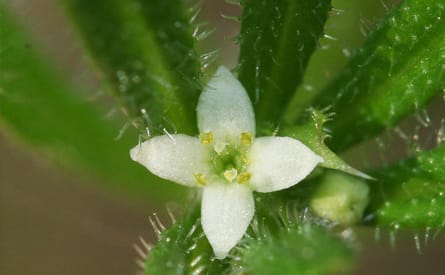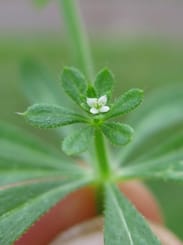
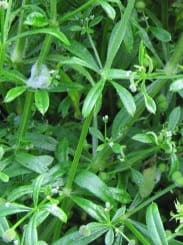
Goosegrass (Galium Aparine)
Proving date: 2003
Proving completed by: Misha Norland, Peter Fraser & The School of Homeopathy
Common name : Cleavers, Clivers, Goosegrass, Catchweed, Sticky Weed, Robin-Run-the-Hedge, Sticky Willy, Sticky willow, Velcro Weed and Grip Grass.
Download: Full proving Goosegrass (Galium Aparine)
Download: Proving rubrics
About Goosegrass
Overwhelmed, responsible, and dragged down. Cancer miasm.
Galium aparine belongs to the Rubiaceae family. Collectively the remedies in this family produce marked excitement and general oversensitivity soon followed by exhaustion and depletion of vital powers. The key feeling of Galium patients is of being swamped, inundated with too much responsibility, and in physical symptoms that became cumulatively overwhelming. This would be in keeping with the signature of the substance as a fast growing weed that rapidly grows over and overwhelms other plants. The power of sexuality and being flirtatious may be experienced by others as predatory and overpowering. Because of moral codes, this behaviour will often be repressed. It has gained laurels in treating cancers.
Patients may have the feeling of being harassed or plagued. Delusions of being followed or that people are calling your name and talking about you, and feelings of being alone and vulnerable. There was a marked polarity expressed as restlessness and agitation, excited and on the edge vs a sense of calmness, lethargy and tiredness. Symptoms and moods were often changeable, unstable or contradictory.
Water features (herbalists use galium as a diuretic) and the key physical symptom was one of pricking. This experience ranged from itchiness through pinpricks to sharp needle-like pains. The pricking was similar to insect bites. The itchiness was often accompanied by numbness, particularly in the face where several provers also experienced a dragging down sensation.
Goosegrass
Goosegrass (also known as cleavers, sticky grass and sticky willy) is an abundant hedgerow weed that is found throughout Europe and North America, springing up luxuriantly about fields and waste places, enjoying moist and grassy places on most types of soil. Most of the plant's popular names are connected with the clinging nature of the herb. Some of its local names are of very old origin, being derived from the Anglo-Saxon 'hedge rife,' meaning a tax gatherer or robber, from its habit of plucking the sheep as they pass near a hedge. By clinging to the coat of any animal that touches them, the dispersal of seeds is ensured and the seeds also spread freely on the wind.
The plant is a herbaceous annual with creeping angular or square shaped stems that can reach up to 3 ft or longer. Stalks and leaves are covered with little hooked bristles that attach themselves to passing objects almost like velcro, fastening themselves in a ladder-like manner to adjacent shrubs. In so doing, cleavers will push its way upwards through the dense vegetation of hedgerows into daylight. The rough, weak stems struggle over and through the other wayside plants, often forming matted masses.
The leaves are narrow and lance-shaped – roughly an inch long and 1/4 inch broad – and are arranged in rosettes or whorls, with 6 or 8 together. They are rough all over, both margins and surface, with the prickles pointing backwards. In May and June goosegrass comes into flower. Goosegrass has small star-shaped, white or greenish-white flowers that are clustered together in groups of 2 or 3 and spring from the axils of the leaves, emerging from early Spring to Summer. They are followed by little globular seed-vessels, about 1/8 inch in diameter, covered with hooked bristles and readily adhering, like the leaves, to whatever they touch.
Goosegrass is of the natural order Rubiaceae. Members of the family are mostly located in tropical climates with many species being noted for the beauty and fragrance of their flowers. The remedy China is the potentised bark of Cinchona officinalis, a South American tree, that also belongs to the Rubiaceae. Ipecacuanha is the powdered root of another member of this order, growing in the forests of Brazil. The most economically important species of the family is Coffea arabica. The British and European representatives of the order (of which goosegrass, the madder [Rubia tinctoria] and our common wild plants – cleavers, bedstraws and sweet woodruff – belong) are of a different character, being herbaceous plants, with slender, angular stems, bearing leaves arranged in whorls, or rosettes and small flowers. Owing to the star-like arrangement of their leaves, all these British species have been assigned to the tribe Stellatae.
Mythology
Geese: Farmers encouraged growth of the plant because geese are extremely fond of the herb, hence the name ‘goosegrass’. It is also believed the name 'goosegrass' relates to parts of the plant that look like the feet of geese!
Beauty and femininity: It was said that a lady's locks would grow strong and long, if they rinsed their hair with an infusion of goosegrass. The infusion was also used in baths to ensure success in affairs of the heart.
History
Derivation of the name: The Ancient Greeks gave goosegrass the name 'philanthropon', from its habit of clinging, and loveman is merely an Anglicised version of this. The plant became known as 'cleavers' as a result of its ability to cling to items, such as clothing. The Latin name of the plant – 'aparine' – also refers to it's creeping habit, being derived from the Greek 'aparo' meaning 'to seize'. The genus name Galium derives from the Greek 'gala' meaning 'milk'. Galiums, especially our lady's bedstraw (Galium verum, so named because it was said to have lined Christ's manger), have the quality of curdling milk and have been used as a vegetable rennet.
Food: Goosegrass is often collected for the purpose of feeding it to poultry, however horses, cows and sheep will also eat it with relish. The leaves and stems of the plant are suitable for human consumption as well, and can be cooked as a leaf vegetable although the numerous small hooks that cover the plant make it less palatable if eaten raw. Goosegrass is in the same family as coffee. The seeds of goosegrass form one of the best substitutes for coffee and contain less caffeine – they simply need to be dried and slightly roasted over a fire. Seeds prepared in this way, can also be added to vegetable soups. The infusion, drunk as a tea, has a soothing effect in cases of insomnia, and induce quiet, restful sleep.
Roots: The plant, like madder, has roots that produce a rich red dye, which gave cheeses such as those from Gloucestershire, their rich orange colour. Birds that eat these plants have bones that are tinged slightly red. Native American Indians used the roots to dye bones red.
Ancient uses: Dioscorides (physician, pharmacologist and botanist), born c. 40 ad, reported that ancient Greek shepherds used the barbed stems to make a rough sieve that was used to strain milk. Later, in the 18th century, Carl Linnaeus, a Swedish botanist, physician and zoologist, reported that the same practice was adopted in Sweden. Dioscorides prescribed goosegrass for weariness. Galen, one of the founders of Roman medicine, described goosegrass as being a cure for obesity writing that, 'it can make fat folk lean'. The plant was also used as an ointment for burns and scalds in the 14th century. Native American Indians used the herb to treat gonorrhoea.
Medicinal uses: of goosegrass are well-documented. It has traditionally been used to treat scurvy, scrofula, psoriasis, eczema, seborrhoea, sunburn, freckles, sores, blisters, wounds and burns. It was also used as a pulp to relieve poisonous bites and stings. This is related to by Gerard in the 17th century, who described goosegrass as being, 'a marvellous remedy for the bites of snakes, spiders and all venomous creatures'. The plant was commonly known as 'tongebledes' (meaning tongue bleed), and the most notable homeopathic use of Galium aparine has been for cancer of the tongue. The herb has a special curative reputation for cancerous growths. The roots of goosegrass contain the chemical asperuloside which is soluble in water and possesses a gentle purgative action. Galen's belief that the plant had a slimming effect on the body was maintained and there are many references in old texts about the plant being used to treat obesity. It supports the lymphatic system in detoxifying the body, and is a powerful diuretic, working on the urinary organs and as a solvent of bladder stones. Goosegrass is used to treat swollen glands, tonsillitis, glandular fever and throat infections. In antique texts, the healing properties are celebrated, and it is still employed as a Spring tonic, chopped small and boiled well. It has been of service in some bleedings, as well as in diarrhoea. In addition it can be used to treat arthritis, earache, and colds.
The proving
Galium aparine invades our space – specifically, the 'space' of herbaceous borders, hedgerows and woodland paths. It is rampant, climbing and clinging up to a couple of metres. It survives by quickly overwhelming an area and sticks tenaciously to other plants for support; also sticking to the passing traffic of humans and beasts for its distribution of seed. The growth seems frail, yet when it is grasped, it clings to and cuts, leaving the softer skin on backs of hands and arms, lightly cut and wounded. Often, a rash develops upon the site and lingers for some days. Goosegrass is satisfying to weed out (provided gloves and long sleeves are worn) because it adheres to itself. While pulling at a piece, it will often pick up neighbouring stems and they too tug loose however, the root system is fibrous and strong. Unless the ground is loosened by trowel or fork, the roots stay firm and growth starts up again.
There is overwhelming evidence to assign this remedy to the Cancer miasm. Indeed there are cases that bear this out. Sarkar writes, 'This is one of the main organ remedies that I use for nodulated tumours, hard tumours – especially of the tongue and oral mucosa. These tumours will have a slow growth period. The remedy is very similar to Calc fluor and Cistus canadensis. It is a chilly remedy, again similar to Cistus canadensis. It is also used for renal stones and calculi, and there is a constant urging for urination. Ulcerated tumours with psoriasis of hands is one of the keynotes that I have found useful when utilising this remedy. Enlarged lymph glands can be treated by Galium aparine as well.'
In the proving, there was stagnation of water in the body – in the lymphatic system, kidneys and bladder – the individual became lethargic and struggled, with a rush of thoughts and desire to clear things out, organising and tidying to avoid being overwhelmed. Provers were bad-tempered and agitated feeling oppressed and overwrought. One prover described this experience as, 'The feeling that there is a conflict between my real self and the proving remedy, like there is a battle going on, between my essence and the new essence, and I have to fight to keep my real self there, to be aware and in control. I need to keep control, keep a hold on my actions'. In relation to the central theme of being overwhelmed and harassed, another prover recorded a dream, saying, '[I was] trying to climb out of a valley before it was flooded; there were very steep sides and I kept sliding down again. I did manage to get to the top, where I went into a catacomb of underground tunnels and chambers. Trying to escape something; no rest; no respite; overwhelmed.' Overwhelm (and stagnation) also relates to the remedy's special affinity for fibrous tissue and treats multiple fibrocystic breasts. In the remedy picture is lymphatic swelling beneath the ear, Morton's neuroma, neurofibromatosis, and itching of the skin that was felt as one of pricking and numbness.
There was a sense of anxiety in the proving, particularly an anxiety about imminent disaster. Provers developed heightened awareness, were alert and oversensitive to noise. Part of this anxiety featured in visions of death and violence, with some provers reporting experiences of being followed and hunted. One reaction to this state is to struggle against it, which was expressed as fighting with the remedy and staying in control – 'The feeling that there is a conflict between my real self and the proving remedy, like there is a battle going on, between my essence and the new essence, and I have to fight to keep my real self there, to be aware and in control. I need to keep control, keep a hold on my actions.' A reaction to this state was one of clearing out, in order to create some space and order. Provers experienced an unusual degree of confusion and forgetfulness. This was physically expressed as clumsiness and making mistakes but was most noticeable in distortions of size or direction and especially of distance. Affairs and sexuality featured in the proving, and in relation to being hunted, were described by one prover as, 'I feel pursued hunted – sexually and I am hunting. The image I had is of me as a monkey in search of new fresh genes for the gene pool of my species and I am looking for an encounter with a lone male, I am in a clearing in the woods'.
Download: Full proving Goosegrass (Galium Aparine)
Download: Proving rubrics
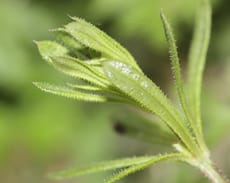
Overwhelmed- Heightened awareness - Bad-tempered - Imminent disaster - Conflict - Order - Affairs - Confusion - Distortion - Alertness - Lethargy - Water - Agitation
Proving Themes
Kingdom:Plantae
(unranked):Angiosperms
(unranked):Eudicots
(unranked):Asterids
Order:Gentianales
Family:Rubiaceae
Genus:Galium
Species:G. aparine
Taxonomy
Goosegrass is a valuable plant and a good cleansing remedy, it supports the lymphatic system to detoxify the body and can be used as a diuretic. The remedy is used to treat swollen lymph glands, tonsillitis, glandular fever and recurrent throat infections. In addition, it can be used to treat eczema, psoriasis, arthritis and seborrhoea.
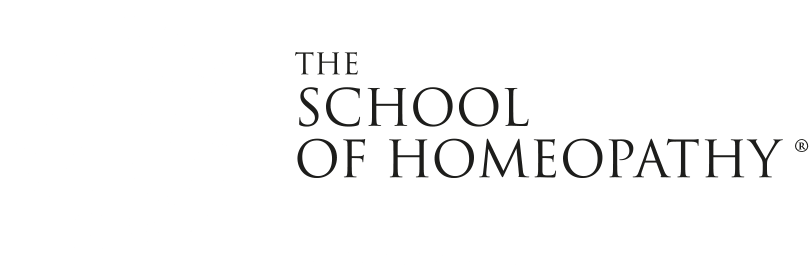
.jpg)
